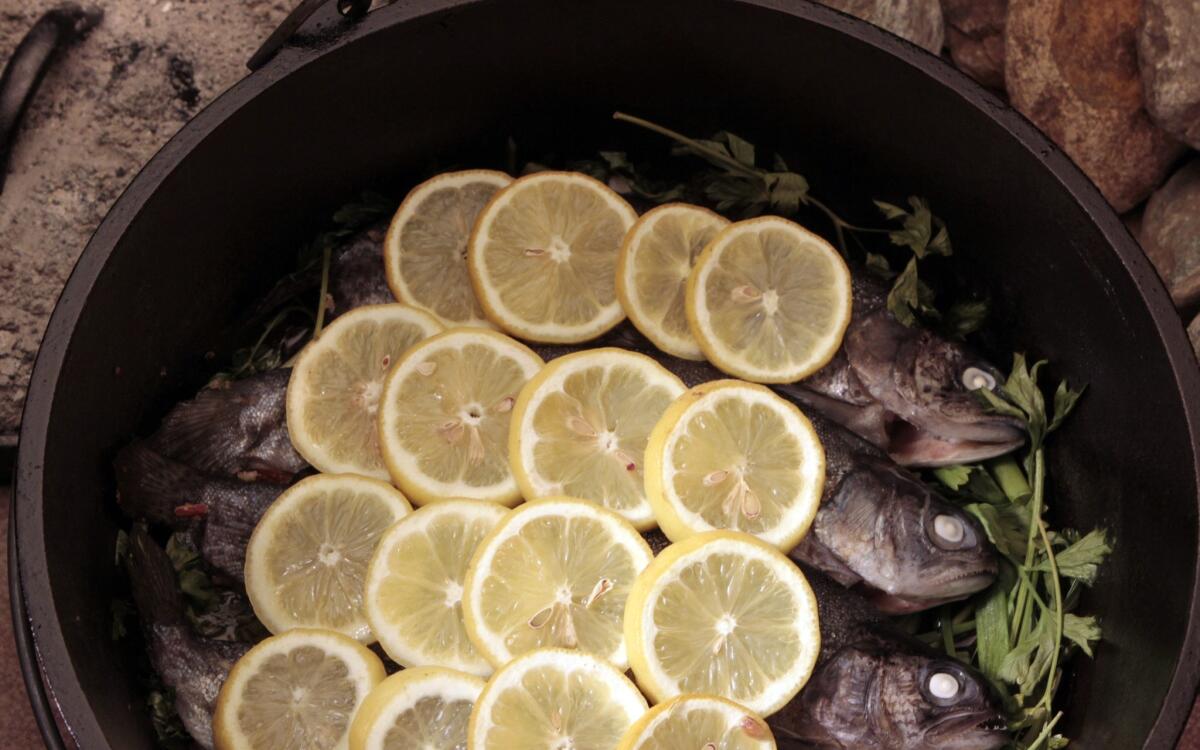Baked rainbow trout

- Share via
It’s officially summer, and the Fourth of July weekend is just around the corner. And from sea to shining sea, Americans will choose to celebrate this great nation of ours outdoors. With food, of course. For many of us, this means backyard barbecues and grilling parties. For others, summer means camping — enjoying the great outdoors with shared meals around a campfire.
Yeah, I know what you’re thinking. Camping and food — at least “good” food — don’t mix.
I’m not knocking franks ‘n’ beans (I like them, actually), but there’s a whole world of camping cuisine beyond the canned stereotypes. Along with my hiking boots and fishing gear, my list of camping must-haves always includes an ingredient list and menu plan. And a camp Dutch oven.
Maybe you’ve seen one before. Similar to the Dutch ovens you might find in the kitchen, a camp oven is a deep pot with a tight-fitting lid, usually made of cast iron. But unlike the kitchen version, a camp oven sits on three stubby legs over hot coals or briquettes. It usually comes with a flanged lid (formed with a lip on the outer edge) to keep ash or coals out of the food when the lid is lifted.
Simple as it sounds, a camp oven is a wonderfully versatile piece of equipment. Use it as a pot or sauté pan. Flip the lid over and use it as a griddle. Or place the food inside the oven and fit the lid tightly over the top, then use it just as you would a conventional oven at home to bake or roast or braise to your heart’s content. All while enjoying your surroundings.
A camp oven is so easy to use. To heat it from the bottom, simply stand the legs over a batch of hot coals, embers or briquettes, or suspend the oven over the campfire. To use like a conventional oven, heat the oven from both the top and bottom, placing twice as many coals on top of the oven to generate enough heat to transfer downward into the oven. Adjust the heat simply by adding or removing coals.
Keep in mind that, as with a conventional oven, you will lose heat every time you open it to check on the food, so lift the lid as little as possible. And if you plan on cooking for 45 minutes or more, remember to add hot coals to keep the heat consistent, brushing away any accumulated ash.
Most mornings, I like to fix a camp frittata in one, sautéing some chopped bacon with onion and grated potato. After I stir in the eggs, I’ll fit over the lid and bake the frittata until puffed and golden.
I also love to use the oven to bake freshly caught trout. Stuff cleaned trout with bacon, capers and bread crumbs, and place them in the oven over a bed of green onion and parsley, topping the fish with sliced lemon. The trout steam in the oven, keeping them moist as they cook.
Desserts often consist of quick bread dumplings baked over fresh fruit, and peaches and blackberries make a perfect combination right about now. As the fruit cooks and begins to bubble from the bottom, the dumplings puff and brown from the heat of the lid.
It’s a perfect — and arguably patriotic — way to enjoy an evening outdoors.
noelle.carter@latimes.com
Follow me on Twitter at @noellecarter
Prepare a batch of coals (at least 27) without starter fluid in a chimney starter until they are hot enough to have formed a thin coating of white ash over the surface of each coal. Alternatively, the fish can be made using a skillet and 13-by-9-inch baking dish, and baked in a conventional oven heated to 375 degrees.
Place a 6-quart (12-inch) Dutch oven over a hot bed of coals, and fry the bacon until the fat is rendered and the bacon begins to crisp, 6 to 8 minutes. Drain the bacon on paper towels, and remove all but 2 tablespoons of the bacon grease (you can save the rest for another use).
Add the mushrooms to the Dutch oven and cook until softened, 4 to 6 minutes. Stir in the garlic and cook until aromatic, 1 to 2 minutes. Remove from heat and mix in the capers, bread crumbs, bacon and almonds. Use your hands to break up the almonds and bacon as the ingredients are mixed together. If the filling feels a bit dry, add the softened butter to moisten the filling before stuffing the trout. Fill each trout with a generous 2 to 3 tablespoons of stuffing.
Line the bottom of the Dutch oven or dish with the parsley sprigs and chopped green onion, forming a bed. Arrange the stuffed fish on the leaves, topping each fish with a few slices of lemon.
Place the oven over about nine of the hot coals (evenly spaced), and evenly space about 18 coals over the lid. Cook until the fish is firm and the flesh just begins to flake, 20 to 25 minutes, careful not to overcook. If cooking in a conventional oven, arrange the fish on a bed of parsley and green onion in the baking dish with lemon slices, covering the dish with foil and baking in a 375-degree oven until done. Serve immediately.
Get our Cooking newsletter
Get a taste of Los Angeles — and the world — with recipes and kitchen tricks from the L.A. Times’ Cooking newsletter.
You may occasionally receive promotional content from the Los Angeles Times.
















